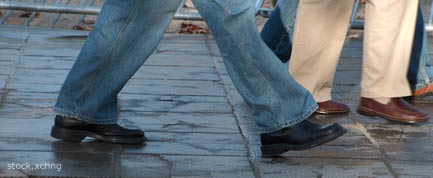'Crowd Farm' Converts Footsteps into Electricity

Two MIT students have found the next new source of energy: you.
A new technology developed by the graduate students would take the energy generated by human movement, such as walking or jumping, in crowded settings and turn it into electricity.
The so-called "Crowd Farm" would work something like this: A responsive sub-flooring system would be placed under, say, the platform of a subway terminal. The blocks that make up the system would depress slightly under the force of human footsteps. As the blocks slipped against each other, they would generate power in the form of an electric current.
That electric current could be used, among other things, to light up signs about the energy created by the pedestrians, the creators say.
"We want people to understand the direct relationship between their movement and the energy produced," said co-creator Thaddeus Jusczyk.
While the Crowd Farm wouldn't work in the home (a single human step generates only enough power to light two 60-watt light bulbs for one second), it could really draw some power from a crowd producing thousands of steps. Some 28,527 steps, for example, could power an entire moving train for a second.
The Crowd Farm could also be used to harness the head-bashing energy at a rock concert.
Sign up for the Live Science daily newsletter now
Get the world’s most fascinating discoveries delivered straight to your inbox.
"Greater movement of people could make the music louder," said Jusczyk.
The students' creation was presented at the Holcim Foundation's Sustainable Construction competition earlier this year, where it took first place.
- Great Inventions: Quiz Yourself
- Power of the Future: 10 Ways to Run the 21st Century
- Power of Pee Runs a Battery

Andrea Thompson is an associate editor at Scientific American, where she covers sustainability, energy and the environment. Prior to that, she was a senior writer covering climate science at Climate Central and a reporter and editor at Live Science, where she primarily covered Earth science and the environment. She holds a graduate degree in science health and environmental reporting from New York University, as well as a bachelor of science and and masters of science in atmospheric chemistry from the Georgia Institute of Technology.









